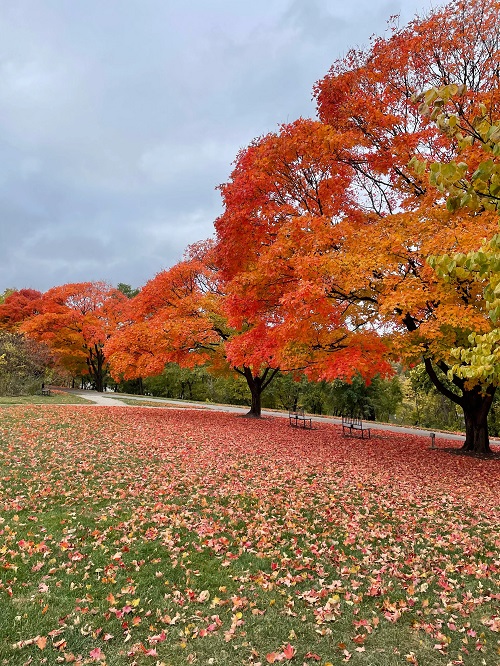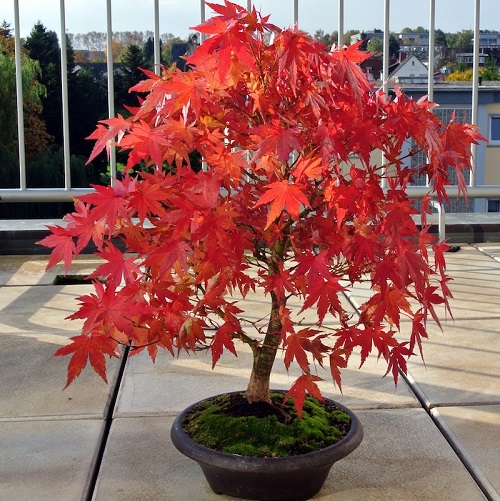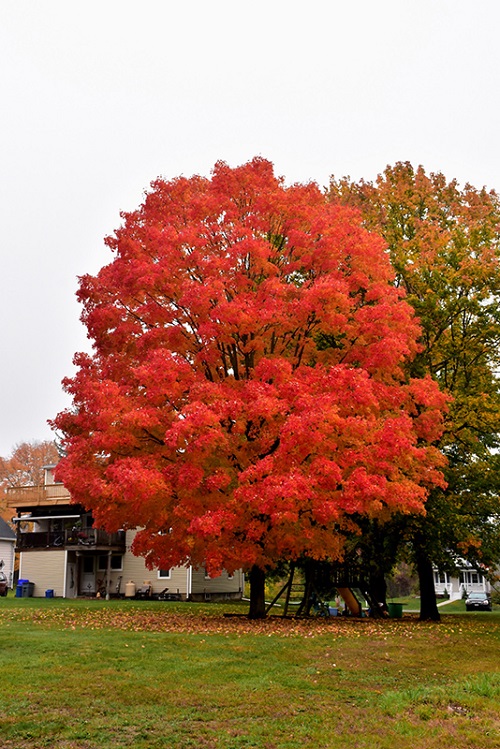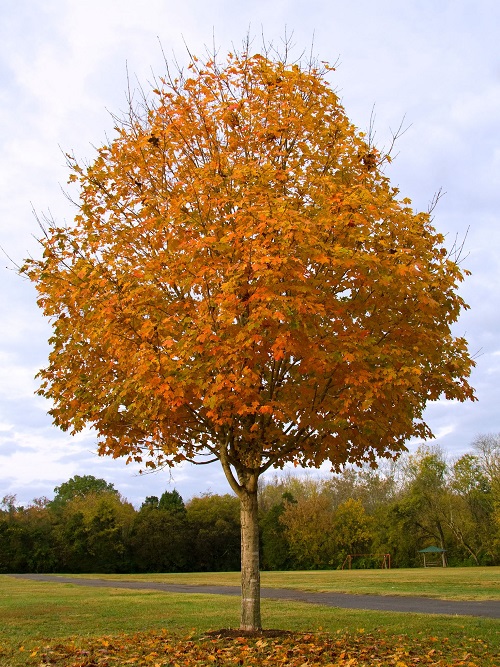Want to grow the magnificent Sugar Maple but don’t know how? We’ve got you covered with this Sugar Maple Tree Growing Guide!

Whether you’re a beginner or an experienced gardener, this Sugar Maple Tree Growing Guide will provide you with essential information and tips for successfully growing and caring for Sugar Maple Tree. Explore the rich history, propagation methods, care requirements, and more to nurture these iconic trees in your landscape.
Best Maple Tree Varieties for Containers
Sugar Maple Tree Information
Native to the hardwood forests of eastern North America, the Sugar Maple Tree ranges from the Midwest to the Atlantic coast, with its presence most concentrated in the Northeast and the Great Lakes region.
It’s also found in the Appalachian Mountains and parts of Eastern Canada. The tree typically thrives in well-drained, moist, and fertile soils, often in mixed forests alongside species like Eastern White Pine and American Beech.
One of the most captivating features of the Sugar Maple Tree is its seasonal leaf color change. During the growing season, leaves are a vibrant green.
Come fall, the tree undergoes a remarkable transformation, displaying a brilliant array of colors ranging from bright yellow to burnt orange and deep red. The intensity of the fall foliage depends on several factors, including light exposure, soil nutrients, and weather conditions.
Uses and Importance
- Maple Syrup: The Sugar Maple is the primary source for maple syrup. Its sap has a higher sugar content compared to other maple species, making it the most efficient choice for syrup production.
- Timber: The wood of the Sugar Maple Tree is hard and durable, making it a popular choice for furniture, flooring, and cabinetry.
- Ecological Value: The tree plays a critical role in its native ecosystems, offering habitat and food sources for various wildlife species.
Pacific Sunset Maple Tree Growing Guide
Propagating Sugar Maple Tree
Ways to Propagate Sugar Maple
- Seed Propagation
- Root Cuttings
- Grafting
- Air Layering
The Most Popular and Reliable Method: Seed Propagation
Seed propagation is generally the most reliable method for propagating Sugar maple trees because it allows for the production of genetically diverse offspring. Sugar maples produce large quantities of seeds, and when properly collected and sown, they can result in healthy and vigorous trees.
Additionally, seeds are readily available and relatively easy to work with, making this method accessible to both home gardeners and commercial growers.
Propagating Sugar Maple Tree from Seeds
- Seed Preparation: Remove any remaining fruit pulp from the seeds. Allow the seeds to air dry for a few days to reduce moisture content.
- Cold Stratification: Place the dry seeds in a plastic bag or container with moist, sterile potting soil or peat moss. Seal the bag or container and store it in a refrigerator at around 33-41°F (1-5°C) for 60-90 days to simulate winter conditions.
- Germination Setup: Fill seed trays or pots with a well-draining, sterile potting mix.
Plant the stratified seeds at a depth of about 1/4 to 1/2 inch (0.6-1.3 cm) in the soil. - Moisture and Temperature: Keep the soil consistently moist but not waterlogged. Maintain a temperature of around 68-72°F (20-22°C) for optimal germination.
- Seedling Care: Once germination occurs (which may take several weeks to a few months), provide ample sunlight or fluorescent lighting to promote healthy growth.
- Transplanting: When the seedlings are large enough and have several sets of true leaves, carefully transplant them into larger pots or directly into the ground. Ensure proper spacing, as Sugar maple can grow quite large.
- Outdoor Planting: Choose a suitable planting location with well-drained soil and partial to full sun. Dig a hole large enough to accommodate the root system of the sapling. Plant the Sugar maple seedling at the same depth it was growing in its container.
- Regular Maintenance: Water the young tree regularly, especially during dry periods, to establish strong roots. Mulch around the base of the tree to retain moisture and control weeds. Monitor for pests and diseases and take appropriate action if needed.
Simple Seed Germination Tips To Grow Every Seed
Keep in mind that Growing Sugar maple trees from seeds is a long-term commitment, and it may take many years before the tree reaches maturity and produces its iconic fall foliage.
Advantages of Seed Propagation
- Genetic Diversity: Produces genetically diverse offspring that can adapt to various environmental conditions.
- Abundance: Sugar maples produce numerous seeds, increasing the chances of successful propagation.
- Ease of Collection: Seeds are relatively easy to collect and handle.
Accessible: Suitable for both home gardeners and commercial growers due to its simplicity.
Choosing a Container for Sugar Maple Tree

You can grow Sugar Maple Trees in containers to limit their height and spread. Start them in a 12-16-inch pot, and based on their growth in the consecutive years, keep on repotting in a one-size bigger pit than the old one.
Requirements for Growing Sugar Maple Tree
Sunlight
Sugar Maple Tree thrive in full sun, where they receive at least 6-8 hours of direct sunlight daily. This promotes healthy growth and vibrant foliage. While sugar maples prefer full sun, they can tolerate partial shade, especially when young. However, too much shade may result in slower growth and less intense fall foliage color.
Place the potted Sugar maple tree outdoors in a location that receives full sun or at least 6-8 hours of direct sunlight each day. A south-facing patio or garden area with ample sunlight is ideal for optimal growth and development.
While Maple sugar is typically an outdoor tree, you can also keep the potted tree indoors during the winter in a cool, well-lit room near a south-facing window to protect it from frost.
Fireglow Japanese Maple Information and Care Guide
Soil
Sugar maples thrive in well-draining soils with a loamy or sandy loam texture that retains moisture without becoming compacted. The soil should be enriched with organic matter, promoting fertility and nutrient availability for healthy sugar maple growth.
Sugar Maple Tree grow best in slightly acidic to neutral soil conditions with a pH level ranging from 6.0 to 7.5. Soil in this pH range provides the ideal environment for nutrient uptake and overall tree health.
Water
Sugar maple trees require consistent and even moisture levels. Water deeply and regularly, especially during dry spells, to keep the soil consistently moist but not waterlogged.
Moisten the growing medium only when the topsoil feels a little dry to the touch.
Temperature
Sugar maple trees thrive in temperate climates with average annual temperatures ranging from 60°F to 90°F (15°C to 31°C). They are cold-hardy and can withstand winter temperatures well below freezing.
In regions with harsh winters, protect young sugar maple trees from frost and freezing temperatures by using frost blankets or wrapping the trunk with tree guards. Ensure they are adequately mulched to prevent temperature fluctuations in the root zone.
Sugar Maple Tree Care
Fertilizer
To boost the growth of this tree, use a balanced liquid fertilizer after diluting it to 1/2 of its strength every 4-6 weeks. Do this till it reaches a height of about 4-6 feet – post that, it will take care of its own, especially if you have directly planted it in the garden.
For potted plants, continue to feed them in the above-mentioned intervals, making sure to avoid it during the winter months.
Dried Banana Peel Powder Fertilizer at Home for Any Plant
Pruning
Sugar Maple Tree generally requires minimal pruning when properly established. Pruning should focus on removing dead, diseased, or damaged branches during late winter or early spring while the tree is dormant. It’s essential to maintain a single leader or central trunk for a healthy structure.
Avoid excessive pruning, as Sugar maples can be sensitive to extensive limb removal, which may lead to stress or decay. Prune with care to promote good air circulation and maintain the tree’s natural shape, but keep in mind that less is often more when it comes to pruning Sugar Maple Tree.
Pests
- Asian Longhorn Beetle: This invasive beetle bores into the tree’s trunk, causing extensive damage to the vascular system and weakening the tree’s structure.
- Maple Borer: Larvae of these beetles tunnel into the inner wood of the tree, potentially leading to limb dieback or tree decline.
- Aphids: These tiny insects feed on sap and can weaken Sugar maple trees, often attracting ants that protect them for their honeydew secretions.
- Scale Insects: Scales attach themselves to branches and leaves, sapping vital nutrients from the tree and causing yellowing or curling of foliage.
- Gypsy Moth: The caterpillars of this invasive moth defoliate Sugar maples and other hardwood trees, potentially stressing the tree.
Best Organic Pest Control Approaches Every Gardener Should Know
Diseases
- Maple Decline: A complex condition that can cause gradual deterioration of Sugar maples, leading to reduced health and vitality.
- Anthracnose: A fungal disease that can cause leaf browning, curling, and defoliation, especially during wet spring seasons.
- Tar Spot: A cosmetic issue where black tar-like spots develop on Sugar maple bark and leaves, rarely causing significant harm.
- Verticillium Wilt: A soil-borne fungus that can cause wilting, yellowing, and dieback of branches in Sugar maple trees.
- Canker Diseases: Fungal infections that lead to sunken, discolored lesions on branches or trunk, potentially weakening the tree.
Sugar Maple Tree – FAQs
1. Can I Tap My Own Sugar Maple Tree for Maple Syrup?
Yes, you can tap your Sugar maple tree in late winter to early spring to collect sap for making maple syrup. Follow proper tapping guidelines and processing methods for best results.
2. How Fast Do Sugar Maple Trees Grow?
Sugar maple trees are slow growers, typically adding 1 to 2 feet (30 to 60 cm) in height per year. It may take several decades for them to reach full maturity.
3. Are Sugar Maple Leaves Poisonous to Animals or Humans?
Sugar maple leaf is not toxic and is not known to be harmful to animals or humans. In fact, they are a vital food source for certain wildlife species.
4. Do Sugar Maple Trees Lose Their Leaves in Winter?
Yes, Sugar maple trees are deciduous, and they shed their leaves in the fall. The leaves turn vibrant colors before dropping, creating the iconic autumn foliage display.



